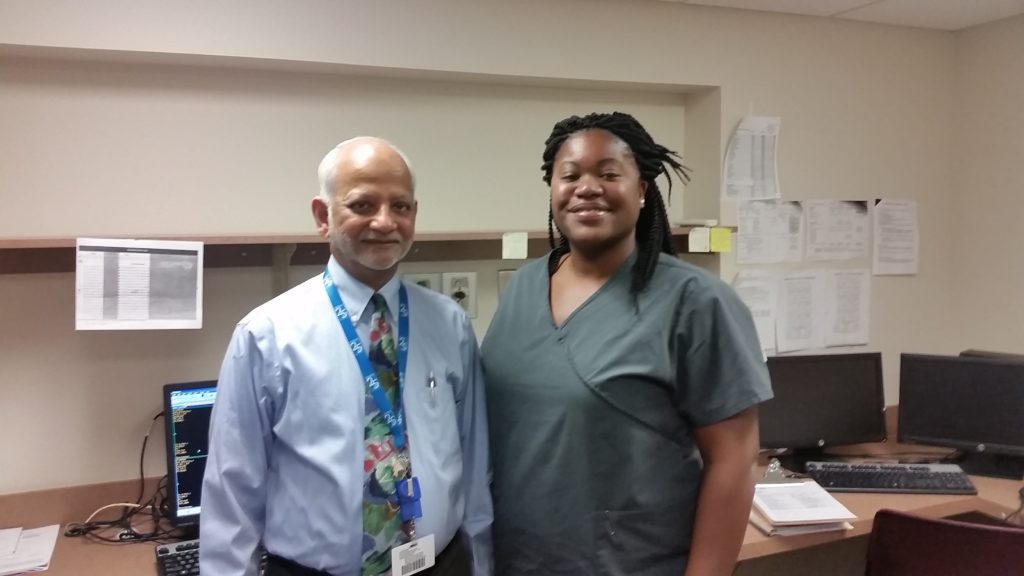SPORTS SCIENCE HAS ITS ROOTS IN PHILADELPHIA
Al Thompson
 Dr. Bala with one of his top assistants Sheena Woodard. Photo by Al Thompson
Dr. Bala with one of his top assistants Sheena Woodard. Photo by Al Thompson The Albert Einstein Healthcare Network is blessed to have an orthopedic surgeon on its staff in Dr. Easwaran Balasubramanian.
It is a beautiful name of Indian heritage. It is also a name that makes people grateful for the cut-and-paste option on their computer.
Imagine if you are the switchboard operator at Einstein or one of the other medical facilities at which Dr. Balasubramanian practices and you’ve been asked to page him over the public address system…it would be a challenge no doubt.
Dr. Balasubramanian realized that and after a few weeks of hearing his name annihilated coming out of the speakers, he decided to keep it simple. He went with “Dr. Bala.”
“They were butchering my name when I came here first,” Dr. Bala said with a laugh. “When they used to page me on the overhead (speakers), it only took a few times when I told them to just call me Dr. Bala.”
So will we.
Dr. Bala grew up in Madras, India, now called Chennai. The city is located on the east coast of India, on the Bay of Bengal. It is the capital of the state of Tamil Nadu. The city is home to Fort St. George, built in 1644 and now a museum showcasing the city’s roots as a British military garrison and East India Company trading outpost.
Dr. Bala said he went to PS High School in Chennai and was a fielder on the school’s cricket team. He said he was a “decent” bowler and helped his team “win a lot of games.”
Like many before him, Dr. Bala walked off the athletic field and onto the field of Orthopedics.
He studied medicine first at Stanley Medical College in Chennai when in 1977 he decided it was time to leave home. He headed to the United States.
“I came to further my education,” Dr. Bala said. “And see the world.”
That world for Dr. Bala and his family ended up in Philadelphia. It was love at first sight in several ways.
“This was the first job I got,” Dr. Bala said. “I had a friend here at Einstein. So I came to Einstein and I got a job as a resident.”
Then he started to grow roots in a very basic way.
“I came to Philadelphia and I got married,” Dr. Bala said of his wife Manjula. “She’s a physician also, she got a residency at the Medical College of Pennsylvania. So we stayed.”
When Dr. Bala finished his residency, he went to Columbia for his Fellowship – his wife stayed at Einstein doing her residency and when he got back from Columbia they decided Philly was their home
What is it about Philadelphia that he likes?
“I like Philadelphia because it’s a big city but it is a small city,” Dr. Bala said. “I’ve been practicing here in Northeast Philadelphia for so long I think I know everybody in the area. Once you grow roots, it’s hard to go.”
Dr. Bala may have left India, but India never left him.
He has gone back to India every year for the past 15 years to treat patients who may be struggling with health care, but he says he does it on his own with some associates.
When asked if what he does is like “Doctors Without Borders,” Dr. Bala said, “kind of like that, but by ourselves. Initially we were doing service for the three weeks we were there, in a hospital, in a rural place.”

Dr. Bala has been treating athletes of all ages, gender and ability since he came to the United States in 1977. Photo by Al Thompson
He said wherever they were needed, he and his friends would make the trip to lend a helping hand.
“When there was an earthquake in Gujarat 15 years ago (2001) we went there to help,” Dr. Bala recalled. “And when the tsunami hit ten years ago (2006 Pangandaran earthquake and tsunami) we went there to run some clinics,”
Now, at the age of 65, he has accepted a different role, just as important, but at a pace he can better manage.
“As I’m getting older now, we are doing more teaching,” Dr. Bala said. “When we do go there we give lectures.” Only orthopedics.
India has always had it challenges that include basic sanitation, disease, social struggles. Dr. Bala addressed the subject with a different approach.
“I am working with a much bigger problem (in India),” Dr. Bala said. “I do more offering (to do) surgery that needs to be done. But I think the present government is doing a lot about hygiene and building more toilets and supplying running water. It helps the medical community when you have better health.”
Dr. Bala said most states in India have systems similar to Medicaid. “That has helped improve the health of people a lot.”
In the United States heath care is a never-ending argument among elected officials tasked with getting a system in place that helps everyone.
Dr. Bala laughed a little when the subject was brought up.
“The Affordable Care Act, in my mind, is a good beginning,” Dr. Bala said. “But what I think would be better would be a system like in Canada or England or like in West European countries and that is centralized health care. You just go and get (treatment). It seems to be working in most places It’s expensive but it is working.”
Dr. Bala continued on about the controversial ACA.
“The Affordable Care Act is not perfect,” he said. “It has problems but it’s a good step…it’s a good step to take.”
Dr. Bala also talked he field and the rapid advancements in orthopedics with regards to knee and hip replacements. The advancements include the quality of the knee and hip replacement parts as well as techniques used by orthopedic surgeons like Dr, Bala.
“It’s true,” He said. “When I started my career in orthopedics a total knee procedure would take about two and half, three hours. Now I can finish the case in 35-40 minutes. I think that’s mostly from the change in the techniques and changing the approaches. In the past, patients would stay 10 days, two weeks before. Now they go home the next day or the day after. In some places it’s done the same day but my patient population is not set for that. To make sure they’re safe.”
Because of the advancements with products like “Forever Hip” produced by Zimmer Biomet as well as non-surgical options such as “Zimmer Gel-One” Patients showing up are younger and younger because they realize how far orthopedics has advanced.
“I think the change in the technology in terms of the metal composition has changed a lot,” Dr. Bala said. “The same way the direction of the titanium to the implants has increased the friendliness to the bone so it stays on better. The plastics that we put between the two prosthesis has changed a whole lot. The ware rate is to say that the plastic will bare the ware a lot less. The addition of vitamin E decreases the (ware and tear) We don’t know exactly how much but it is much less.”
In in layman’s terms, hip and knee replacements are now almost always a one-and-done for life procedure.
Dr. Bala said it will only get better an continue to improve the quality of people’s lives.
“I have been in the field for the past 35 years from arthroscopy, to ACL, reconstruction, to joint replacements including partial knee replacements,” He said. “And robotic surgery, it is really an exciting field to be in right now.”
Like most Philadelphians, he loves local sports.
“I’m a big sports fan,” Dr. Bala said.
He is a former Phillies and Eagles season ticket holder. He raised three children in Philadelphia area and they attended games as a family. “But now that my kids are gone from the area I gave up the seats,” he said with a sigh.
Dr. Bala said he will practice at Einstein for five more years…then retire. But he said he will always have time to go back to India.
“I certainly will and I think once we retire we can do it more.”
Dr. Bala is more than just a sports fan. He treats many active athletes, young and old and has treated many pro athletes who came to him to have old knee and hip injuries taken care now that there is new technology and breakthroughs.
“I do get a lot of sports patients,” said Bala, who is a self-proclaimed vegetarian. “A lot of them were high school athletes who were injured in the early 70s and can by much improved with today’s knee and hip replacement products and technology. They are all doing really well.”
Dr. Bala is also a student of the history of sports medicine. One of the reasons he likes Philadelphia is because of its contribution to the start of sports medicine itself, mainly through the pioneering efforts of orthopedic surgeon Dr. Joe Torg and athletic trainer Ted Quedenfeld.

Philadelphia natives Dr. Joe Torg (pictured) along with athletic trainer Ted Quedenfeld are credited with starting sports science as we know it today.
“Philadelphia is where sports medicine started, in the early 70s” Dr. Bala said. “Joe Torg had a trainer named Ted Quedenfeld and they saw while covering Philadelphia public schools that changes needed to be made in everything including equipment. They felt there was a lot of ACL injuries to the kids. When they looked into that, they found it was the length of the spikes in their shoes that was causing the problems. Because when they cut, it destroyed the knee. In the 70s there was less sophistication with surgery. That is when they started the sports medicine industry.”
Dr, Torg and Quedenfeld opened up a field of medicine that is still expanding rapidly.
The Philadelphia Sports Medicine Congress was later created and gives awards to the area’s top sports medicine doctor and trainer in their names every year.
“They started the industry and they started making it mandatory for all schools to report all injuries.” Dr. Bala said. “At Temple we had a huge practice of people who had surgeries in the 70s on the ACL and we got a lot of knee replacements from them.”
The 2017 Philadelphia Sports Medicine Congress Awards will take place Friday, June 16, 2017 Connelly Auditorium, Hamilton Building Thomas Jefferson University
Because of people like Dr. Torg, Quedenfeld and Dr. Bala, no matter how you pronounce it, the future of sports medicine is bright. *
Follow Al Thompson on Twitter @thompsoniii












